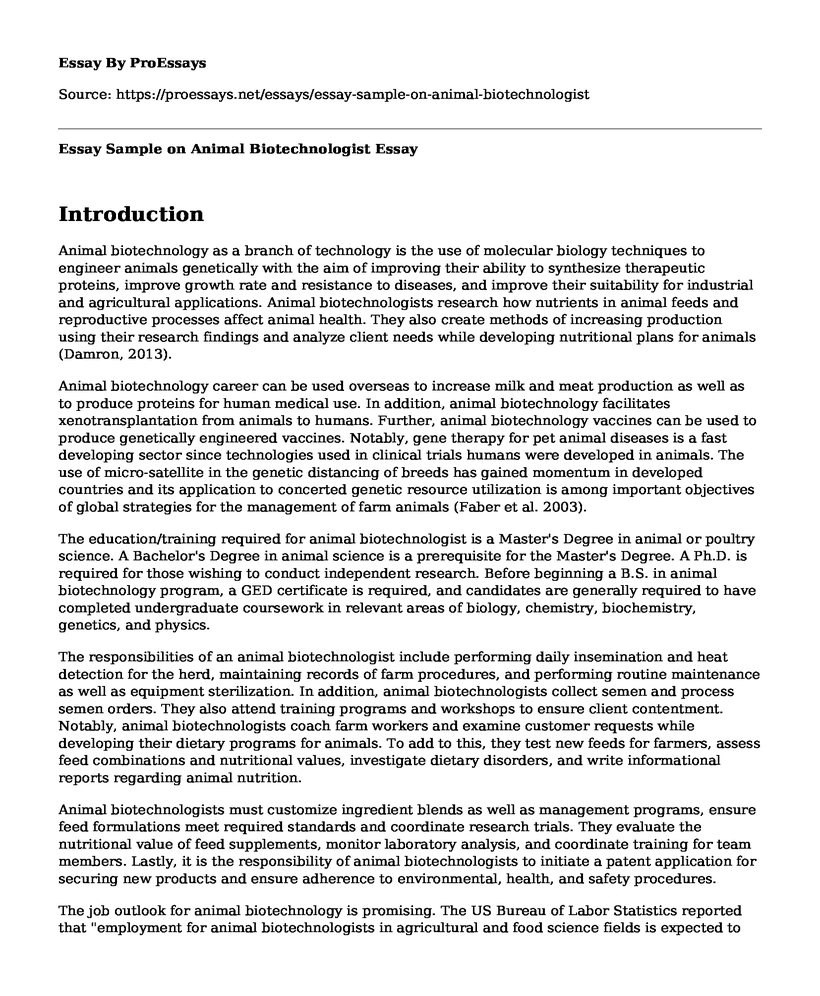Introduction
Animal biotechnology as a branch of technology is the use of molecular biology techniques to engineer animals genetically with the aim of improving their ability to synthesize therapeutic proteins, improve growth rate and resistance to diseases, and improve their suitability for industrial and agricultural applications. Animal biotechnologists research how nutrients in animal feeds and reproductive processes affect animal health. They also create methods of increasing production using their research findings and analyze client needs while developing nutritional plans for animals (Damron, 2013).
Animal biotechnology career can be used overseas to increase milk and meat production as well as to produce proteins for human medical use. In addition, animal biotechnology facilitates xenotransplantation from animals to humans. Further, animal biotechnology vaccines can be used to produce genetically engineered vaccines. Notably, gene therapy for pet animal diseases is a fast developing sector since technologies used in clinical trials humans were developed in animals. The use of micro-satellite in the genetic distancing of breeds has gained momentum in developed countries and its application to concerted genetic resource utilization is among important objectives of global strategies for the management of farm animals (Faber et al. 2003).
The education/training required for animal biotechnologist is a Master's Degree in animal or poultry science. A Bachelor's Degree in animal science is a prerequisite for the Master's Degree. A Ph.D. is required for those wishing to conduct independent research. Before beginning a B.S. in animal biotechnology program, a GED certificate is required, and candidates are generally required to have completed undergraduate coursework in relevant areas of biology, chemistry, biochemistry, genetics, and physics.
The responsibilities of an animal biotechnologist include performing daily insemination and heat detection for the herd, maintaining records of farm procedures, and performing routine maintenance as well as equipment sterilization. In addition, animal biotechnologists collect semen and process semen orders. They also attend training programs and workshops to ensure client contentment. Notably, animal biotechnologists coach farm workers and examine customer requests while developing their dietary programs for animals. To add to this, they test new feeds for farmers, assess feed combinations and nutritional values, investigate dietary disorders, and write informational reports regarding animal nutrition.
Animal biotechnologists must customize ingredient blends as well as management programs, ensure feed formulations meet required standards and coordinate research trials. They evaluate the nutritional value of feed supplements, monitor laboratory analysis, and coordinate training for team members. Lastly, it is the responsibility of animal biotechnologists to initiate a patent application for securing new products and ensure adherence to environmental, health, and safety procedures.
The job outlook for animal biotechnology is promising. The US Bureau of Labor Statistics reported that "employment for animal biotechnologists in agricultural and food science fields is expected to grow by 5% from 2014- 2024". Technical, social, and economic trends such as DNA sequencing and standardization of biological parts are likely to drive the development of biotechnology in the next 5-10 years (Eenennaam, 2006).
Conclusion
I find this career appealing given my robust research background and the zeal I have to work in a laboratory setting. I also find the career appealing since I see biotechnology as a key to a higher quality of life as it produces cures of health disparities, develop clean energy sources, and develop high yielding plants and animals. Equally, biotechnology employment exists across several industries, and biotechnologists have a range of careers to choose.
References
Faber, D. C., Molina, J. A., Ohlrichs, C. L., Vander Zwaag, D. F., & Ferre, L. B. (2003). Commercialization of animal biotechnology. Theriogenology, 59(1), 125-138.
Van Eenennaam, A. (2006). What is the future of animal biotechnology?. California agriculture, 60(3), 132-139.Madan, M. L. (2005). Animal biotechnology: applications and economic implications in developing countries. Revue Scientifique Et Technique-Office International Des Epizooties, 24(1), 127.
Damron, W. S. (2013). Introduction to animal science: global, biological, social, and industry perspectives.
Cite this page
Essay Sample on Animal Biotechnologist. (2022, Jun 19). Retrieved from https://proessays.net/essays/essay-sample-on-animal-biotechnologist
If you are the original author of this essay and no longer wish to have it published on the ProEssays website, please click below to request its removal:
- Effects of Light Intensity and Carbon Dioxide on Photosynthesis
- Eugenics and the Supreme Court Case of Buck vs. Bell
- Plant Viral Infection Essay
- A Discussion on Respiratory System Paper Example
- Essay Sample on Animal Testing for Cosmetics: Cruelty or Necessity?
- Animal Testing: Unethical and Inhumane Practice - Essay Sample
- Classifying Animals: A Unified Model - Essay Sample







